How Many Solar Panels Are Needed to Run an Air Conditioner?
Running an air conditioner with solar power is becoming increasingly popular due to the rising cost of electricity and the growing focus on sustainable living. However, determining how many solar panels are required for your AC unit depends on various factors. Solar panel requirements vary based on the type of AC you own, the power consumption, and the solar panel capacity. Let’s break down these factors to determine how many solar panels you need for your air conditioner.
Factors Affecting the Number of Solar Panels
Type of AC (Inverter vs. Conventional)
One of the key factors that influence the number of solar panels required to run your AC unit is whether you own an inverter AC or a conventional AC.
- Inverter ACs: These are more energy-efficient as they can adjust their speed according to the room temperature. They consume less power because they don’t continuously start and stop. As a result, inverter ACs are an excellent choice for powering with solar energy. Generally, inverter ACs use about 30-40% less energy than their non-inverter counterparts, reducing the number of solar panels needed.
- Conventional (Non-Inverter) ACs: These units operate at full power when switched on and continue running until the desired temperature is achieved. Non-inverter ACs tend to consume more electricity, meaning you will need more solar panels to run the system. These units are less efficient compared to inverter models, so they require larger solar systems to meet their power demand.
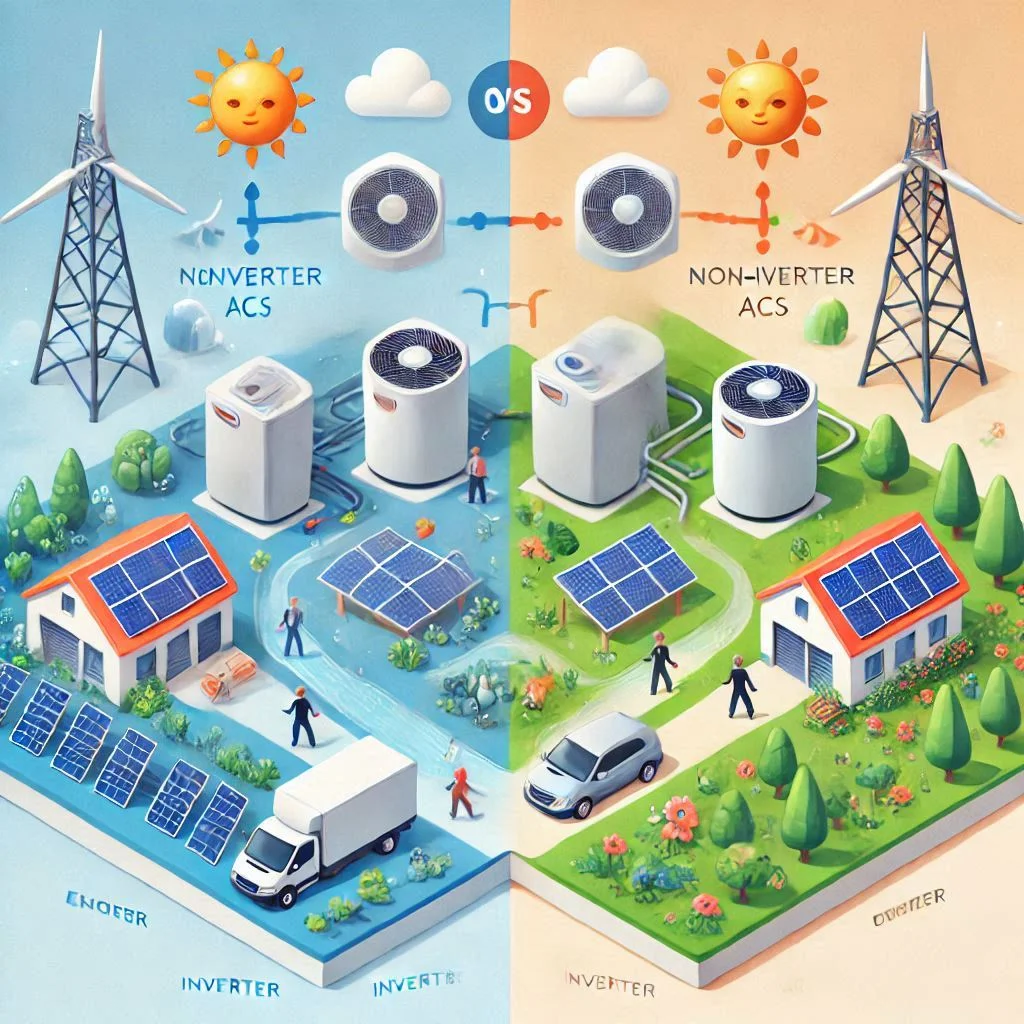
Solar Panel Capacity
The capacity of the solar panels you install plays a significant role in determining how many panels are needed to run your air conditioner. Solar panels typically have capacities ranging from 250W to 400W per panel. To calculate the number of panels needed, you’ll need to consider both the AC’s energy consumption and the solar panel wattage.
To calculate solar panel requirements:
- Determine the wattage of your AC – An average 1.5-ton AC uses around 1500 to 2000 watts per hour.
- Find the solar panel output – A 300W solar panel will produce 300 watts per hour of direct sunlight.
- Use the formula: Number of Panels=AC’s Power ConsumptionSolar Panel Output\text{Number of Panels} = \frac{\text{AC’s Power Consumption}}{\text{Solar Panel Output}} Number of Panels=Solar Panel OutputAC’s Power Consumption
For example, a 1.5-ton inverter AC consuming 1500 watts requires 5 solar panels of 300W each (1500/300).
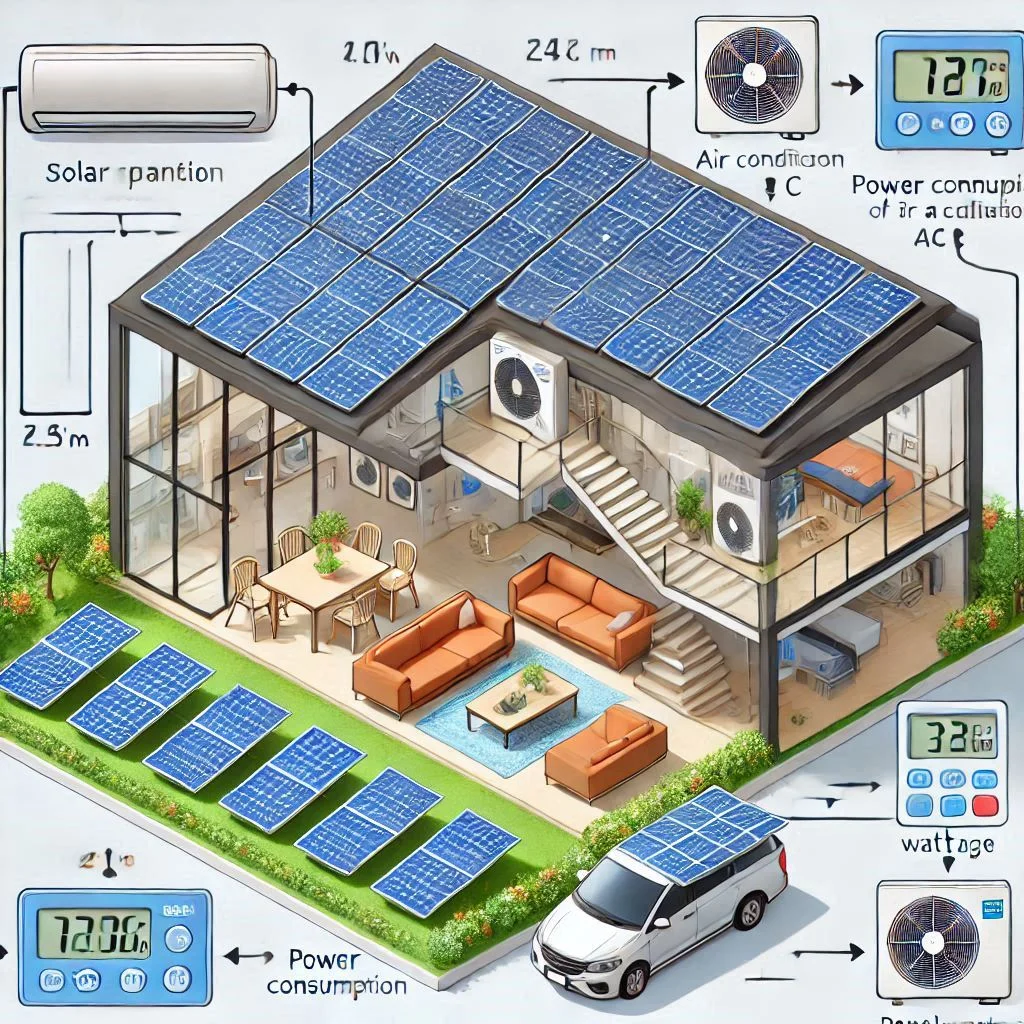
Energy Efficiency Ratings (EER & SEER)
The Energy Efficiency Ratio (EER) and Seasonal Energy Efficiency Ratio (SEER) are important metrics to consider when calculating how many solar panels you’ll need to power your AC.
- EER (Energy Efficiency Ratio): This measures the cooling efficiency of an air conditioner when running at full load. The higher the EER, the less energy the AC consumes for cooling, which translates to fewer solar panels needed.
- SEER (Seasonal Energy Efficiency Ratio): SEER measures the cooling efficiency over a typical cooling season. A higher SEER rating indicates that the air conditioner uses less energy to cool over time, making it a more efficient choice for solar power.
When purchasing an AC, look for units with a high EER and SEER rating. These will reduce the amount of energy required to cool your space and, in turn, reduce the number of solar panels necessary to run the unit.
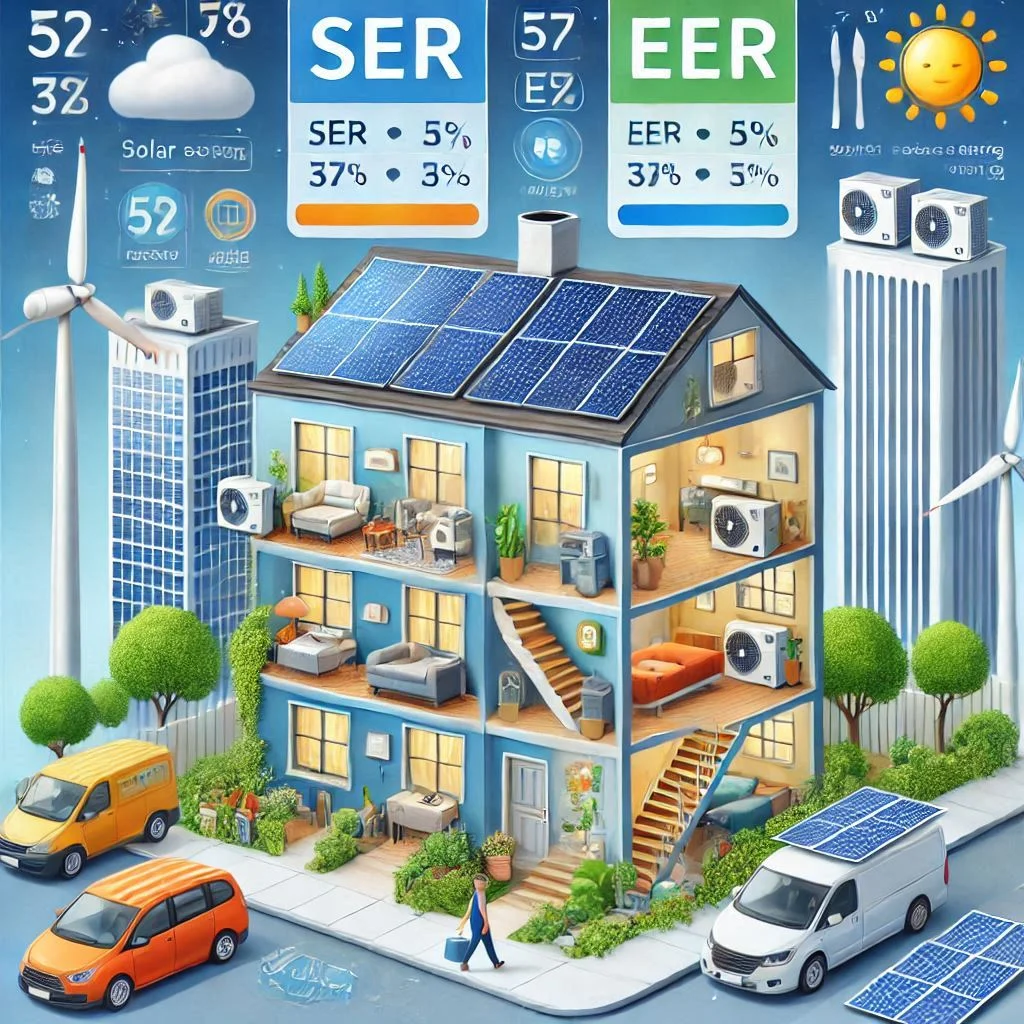
Can You Run an AC on Solar Panels?
The idea of running an air conditioner (AC) with solar power is an attractive one, especially as energy prices rise and people look for more sustainable ways to cool their homes. The short answer is yes, you can run an AC on solar panels—but it depends on several factors like the size of your AC, the solar panel capacity, and whether you choose an on-grid or off-grid system. In this section, we will explore these factors in detail, and provide an overview of the two most common solar panel systems used to power air conditioners.
On-Grid vs. Off-Grid Systems
When it comes to powering an air conditioner with solar panels, there are two primary options: on-grid systems and off-grid systems. Let’s look at both to determine which one is best for your needs.
On-Grid Systems
On-grid solar systems, also known as grid-tied systems, are connected to your local electricity grid. They allow you to generate your own solar power while still relying on the grid when necessary.
- How it works: When your solar panels generate excess power, it is fed back into the grid. In return, you may receive credits or compensation from your utility company (this is known as net metering). On-grid systems do not require batteries for backup.
- Pros:
- Lower upfront costs since you don’t need to install batteries.
- Flexibility to use grid electricity when solar power is insufficient (such as at night or on cloudy days).
- Net metering helps reduce overall energy costs.
- Cons:
- You will still depend on the grid during power outages.
- The efficiency of your solar system is tied to the availability of sunlight.
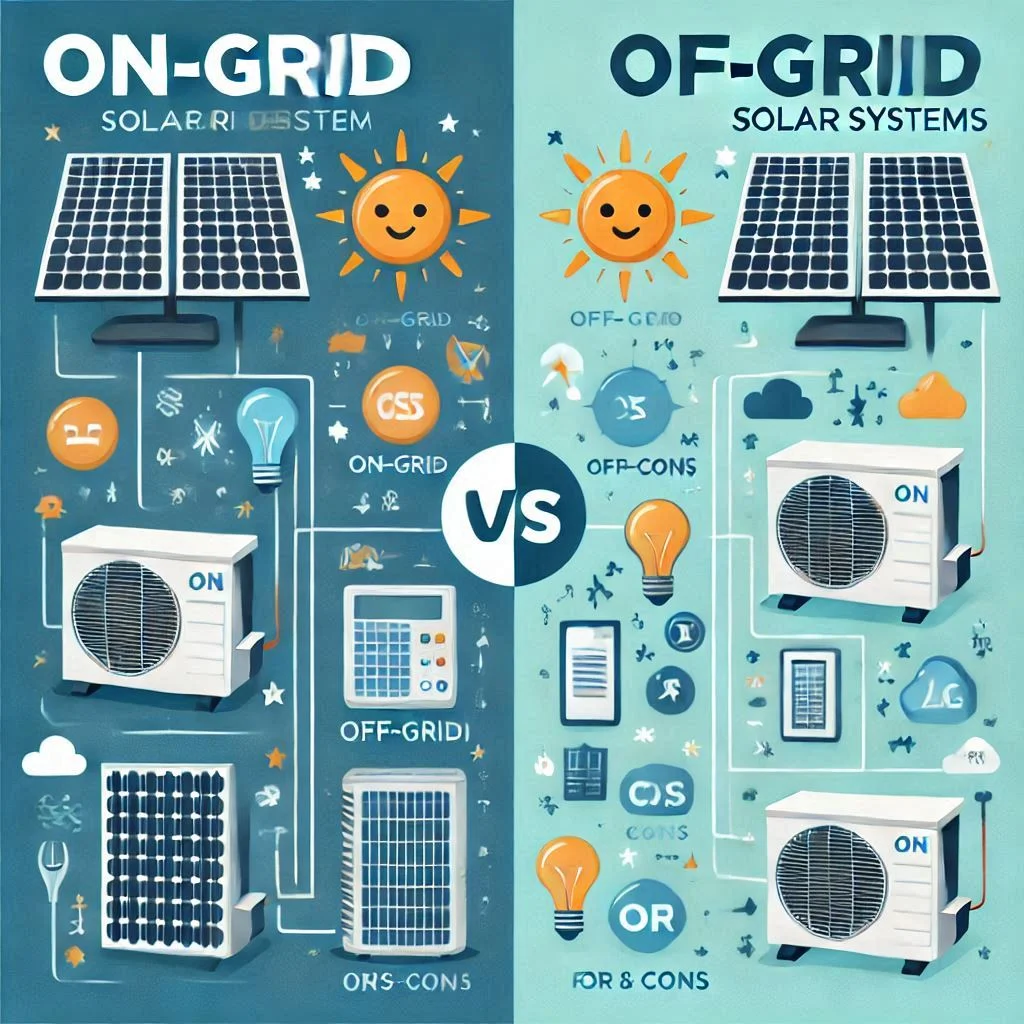
Off-Grid Systems
Off-grid solar systems are independent of the electricity grid. These systems use solar power exclusively and often incorporate battery storage to ensure you have power at all times.
- How it works: Off-grid systems typically include solar panels, inverters, and batteries. When your solar panels generate excess power during the day, it is stored in batteries for use during the night or when the sun is not shining.
- Pros:
- Complete independence from the grid, ideal for remote locations.
- Can be used for powering off-grid homes or cabins.
- Offers energy security, especially during power outages.
- Cons:
- Higher initial investment due to the cost of batteries and other components.
- Requires careful planning to ensure you have enough storage capacity to run your AC during non-sunny periods.
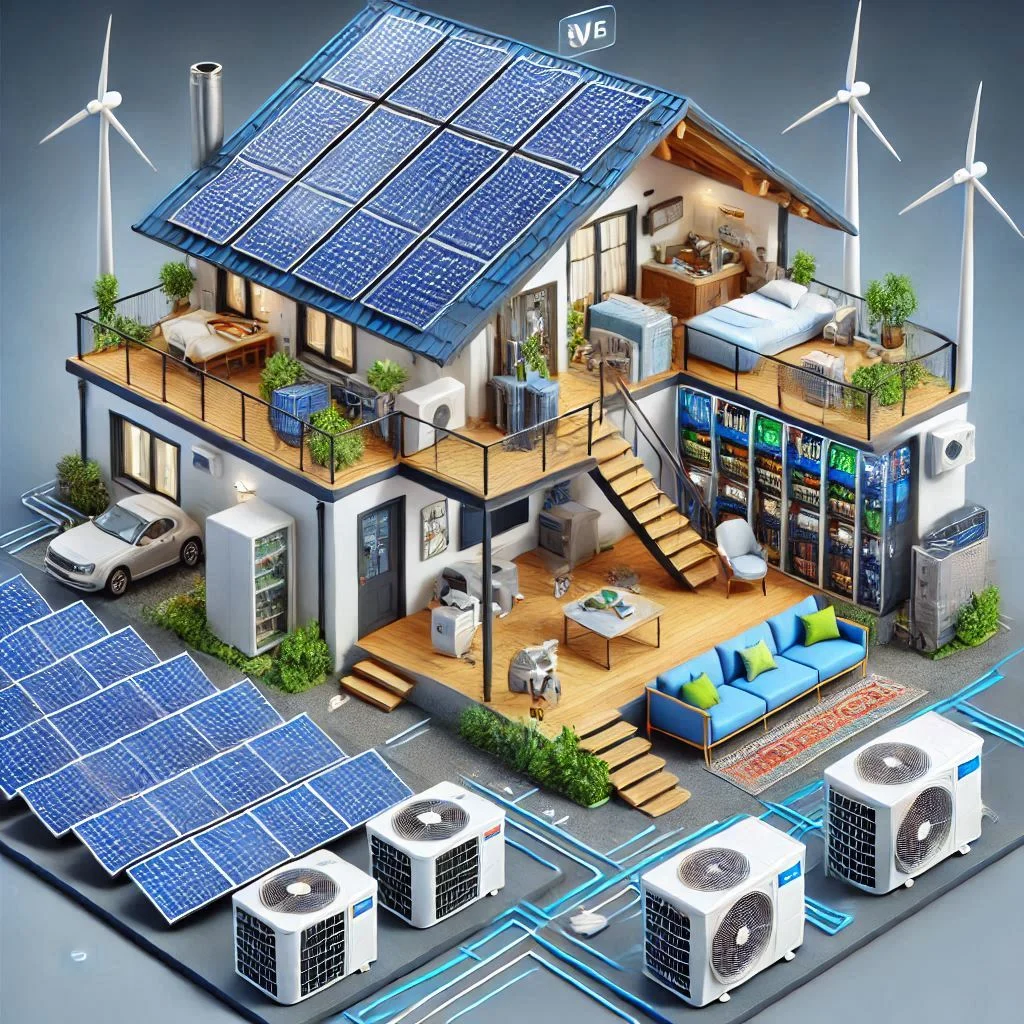
Backup Solutions: Off-Grid & Battery Storage
When considering how to run your AC with solar power, you may want to explore backup solutions that provide uninterrupted power, especially if you live in an area with unreliable grid access or frequent power outages. Battery storage is an essential component of an off-grid system and can also enhance the performance of an on-grid system.
Battery Storage for Off-Grid Systems
In off-grid systems, battery storage is crucial for running appliances like air conditioners when the sun is not shining. Batteries store excess energy generated during the day and release it at night or during cloudy periods.
- Types of Batteries:
- Lithium-Ion Batteries: These are the most common and efficient type of battery for off-grid systems. They last longer and require less maintenance than traditional lead-acid batteries.
- Lead-Acid Batteries: A less expensive option, but they have a shorter lifespan and are less efficient than lithium-ion batteries.
- How Battery Storage Works: During the day, the solar panels generate power, which is used to run the AC and charge the batteries. Once the sun goes down, the batteries release stored energy to power the AC unit. Depending on the size of the battery bank, you may be able to run your AC for several hours or even overnight.
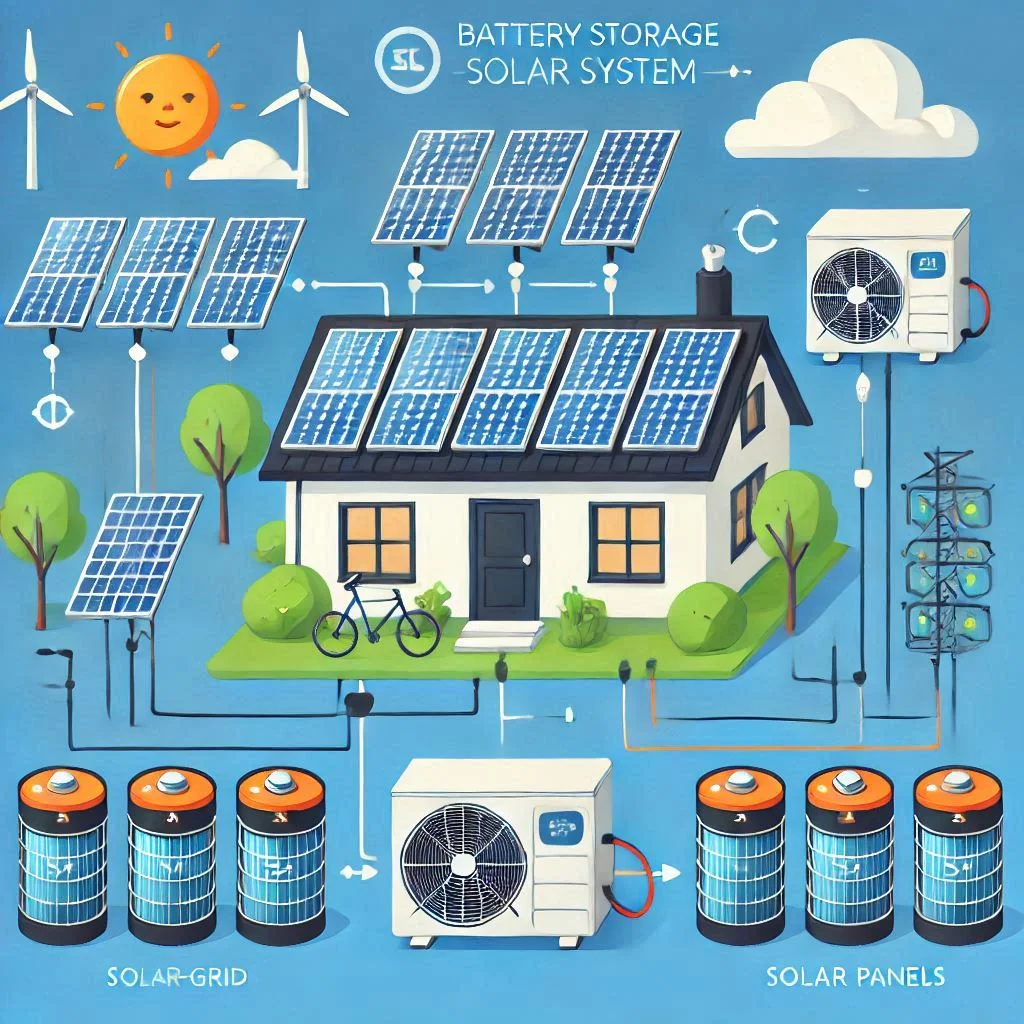
Backup Power for On-Grid Systems
For grid-tied systems, you can incorporate backup power solutions to maintain AC operation during power outages. While on-grid systems rely on the grid for backup, adding solar battery storage allows you to have an extra layer of security.
- Solar Batteries in On-Grid Systems: Adding solar batteries to an on-grid system allows you to store excess power during the day and use it at night or during power cuts, making your AC more reliable even when the grid is down. In this case, the solar panels still feed power into the grid during the day, and any excess is stored in the batteries for later use.
- Benefits of Backup Power:
- Keep your AC running during power outages.
- Reduce dependence on the grid, especially in areas with unreliable electricity supply.
- Lower energy bills by utilizing stored solar energy during peak grid pricing times.
How to Calculate Solar Panel Requirements for Your AC
Calculating how many solar panels are required to power your air conditioner is crucial to ensure a sufficient and efficient solar power setup. To properly determine solar panel requirements, you’ll need to consider your AC’s power consumption and match it with the output capacity of the solar panels you plan to install. This process involves analyzing your AC’s energy needs, the size of the solar panels, and the available sunlight in your region.
By understanding how to calculate solar panel requirements for your AC, you can avoid underestimating or overestimating the number of panels needed, which will help you reduce energy costs while ensuring optimal performance. Let’s break down the steps for accurately calculating the number of solar panels required for your air conditioner.
Determining AC Power Consumption
Before calculating how many solar panels are needed, it’s essential to determine the power consumption of your AC unit. This can vary based on the size of the unit, type (inverter vs. non-inverter), and energy efficiency.
Step 1: Find the AC’s Power Rating
AC units usually have a power rating listed in watts or kilowatts (kW). For example, a 1.5-ton AC typically consumes about 1500 to 2000 watts per hour.
- How to Calculate: To determine the daily power consumption, multiply the AC’s wattage by the number of hours the AC operates daily.Formula:Power Consumption (Wh)=AC Wattage (W)×Operating Hours (h)\text{Power Consumption (Wh)} = \text{AC Wattage (W)} \times \text{Operating Hours (h)}Power Consumption (Wh)=AC Wattage (W)×Operating Hours (h)For instance, if you have a 1.5-ton AC (1500 watts) running for 8 hours a day, the power consumption will be:
1500W×8h=12,000Wh(12kWh)1500W \times 8h = 12,000 Wh (12 kWh)1500W×8h=12,000Wh(12kWh)This means your AC consumes 12 kWh of electricity daily.
Step 2: Consider the Seasonal Usage
Since the air conditioner is mostly used during the warmer months, it’s important to account for the seasonal usage. If you live in a region with hot summers, your AC usage might be much higher during this period. However, during milder months, you may use the AC less, which could affect the total number of panels needed for year-round operation.
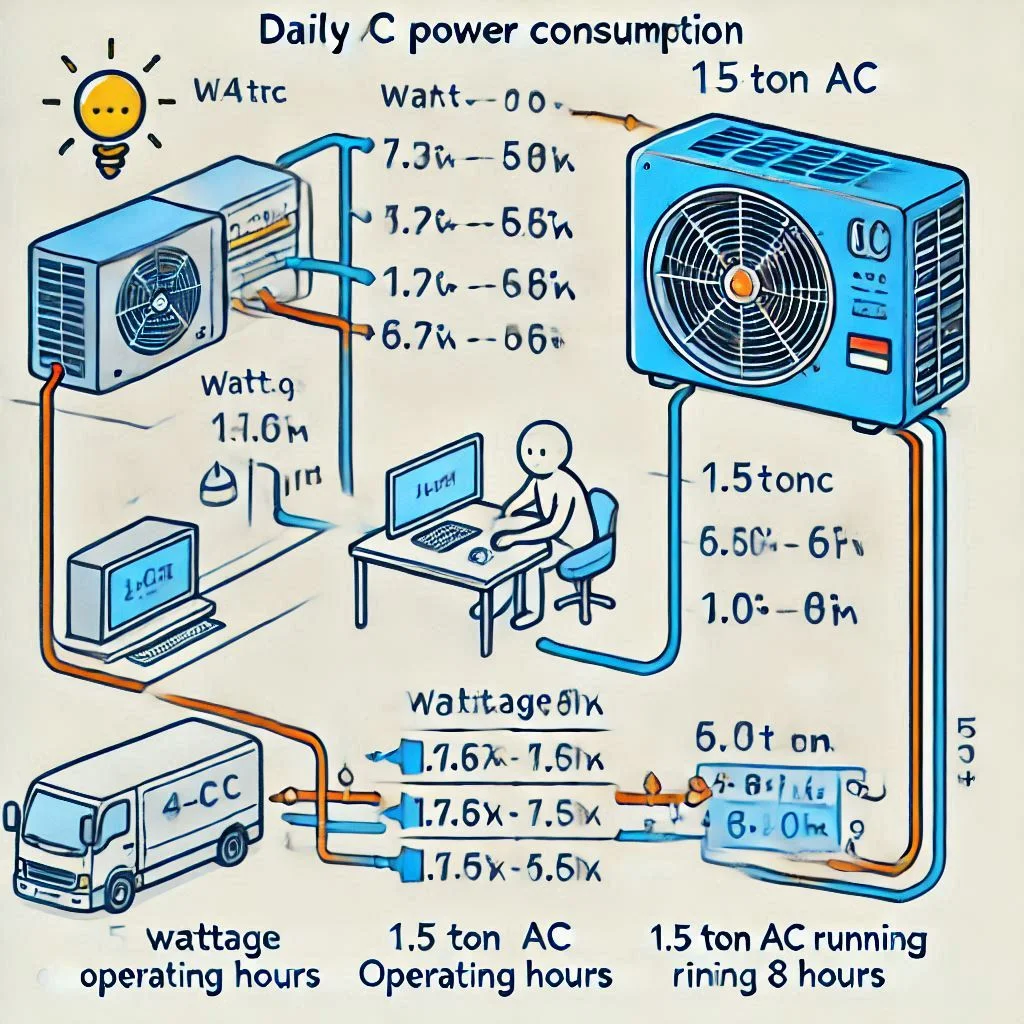
Matching Solar Panel Output to AC Demand
Once you have determined the power consumption of your AC unit, the next step is to match that demand with the output of your solar panels. This requires understanding the solar panel wattage, the amount of sunlight your location receives, and how much power your panels can generate.
Step 1: Solar Panel Wattage
Solar panels come in various wattage options, typically ranging from 250W to 400W per panel. The output of each solar panel depends on factors like efficiency, location, and exposure to sunlight.
- Example: If you are using a 300W solar panel, it will generate 300 watts of power per hour under optimal conditions.
Step 2: Calculate the Number of Panels Required
To calculate the number of solar panels required, divide the daily power consumption of your AC by the solar panel wattage. This gives you the total amount of solar energy needed to meet your AC’s demand.
Formula:
Number of Panels=Daily Power Consumption of AC (Wh)Solar Panel Wattage (W)×Sunlight Hours (h)\text{Number of Panels} = \frac{\text{Daily Power Consumption of AC (Wh)}}{\text{Solar Panel Wattage (W)} \times \text{Sunlight Hours (h)}}Number of Panels=Solar Panel Wattage (W)×Sunlight Hours (h)Daily Power Consumption of AC (Wh)
If your AC consumes 12,000Wh per day, and you install 300W solar panels with an average of 5 sunlight hours per day in your area, the calculation would be:
12,000Wh300W×5h=8 solar panels\frac{12,000Wh}{300W \times 5h} = 8 \text{ solar panels}300W×5h12,000Wh=8 solar panels
So, you would need 8 solar panels of 300W to fully power your 1.5-ton AC for 8 hours a day.
Step 3: Factor in Panel Efficiency and Location
The sunlight hours you get per day vary based on your location. For example, areas with more direct sunlight (like Florida or Arizona) will require fewer panels compared to areas that experience more cloudy or rainy days.
- Optimization Tip: Choose higher-efficiency solar panels (like 350W or 400W) if you want to reduce the number of panels needed.
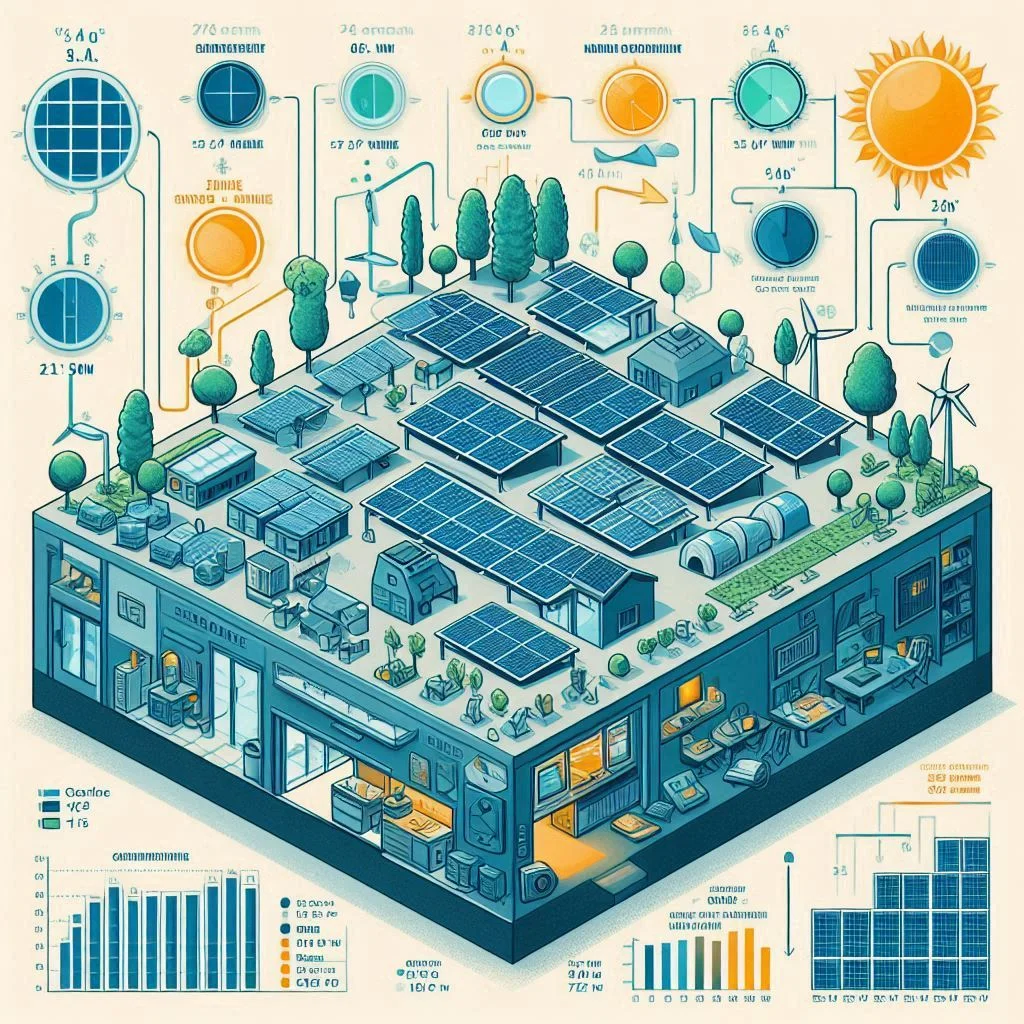
Step 4: Consider Battery Storage for Backup Power
If you are in an area with frequent power outages, you might want to include battery storage in your solar system. Battery systems store excess solar power generated during the day, which can then be used to power your AC during nighttime or cloudy periods.
- How Much Storage Do You Need?: Ideally, you should have enough battery storage to cover your AC’s power consumption during the night. This will ensure that your system is always ready to run your air conditioner without relying on the grid.
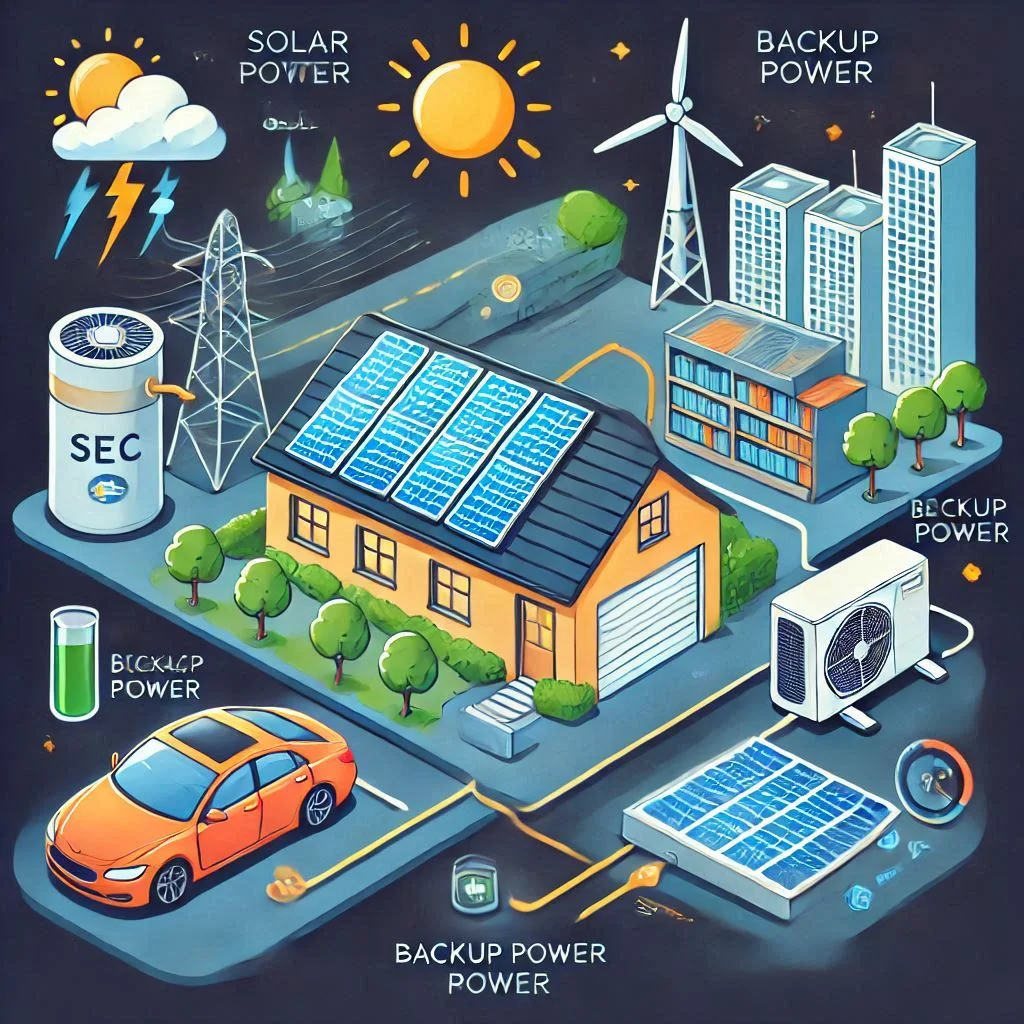
Solar Panel Performance for Air Conditioning
Solar panels provide a renewable and eco-friendly way to power air conditioning units. However, the performance of solar panels for AC systems depends on various environmental factors, including the time of day and the weather conditions. Understanding how solar panels perform at different times and seasons can help you optimize your solar energy system to ensure reliable AC operation.
In this section, we’ll explore how daytime vs. nighttime solar power affects the efficiency of solar-powered air conditioning and how solar panel efficiency changes in winter conditions.
Daytime vs. Nighttime Solar Power
Solar panels generate electricity by capturing sunlight, so their performance naturally depends on the availability of sunlight. Therefore, there is a significant difference in how solar panels perform during the day compared to the night.
Daytime Solar Power
During the day, when the sun is shining, solar panels operate at their peak efficiency. The more sunlight the panels receive, the more electricity they generate. Here’s how solar panels work during daylight hours:
- Peak Efficiency: Solar panels generate the most energy when the sun is directly overhead. During peak sunlight hours (typically between 10 a.m. and 4 p.m.), the panels convert sunlight into electricity at their highest capacity.
- Air Conditioner Operation: With sufficient sunlight, solar panels can easily power an air conditioner. If your solar system is designed correctly, it can meet your AC’s daily power demand during these hours.
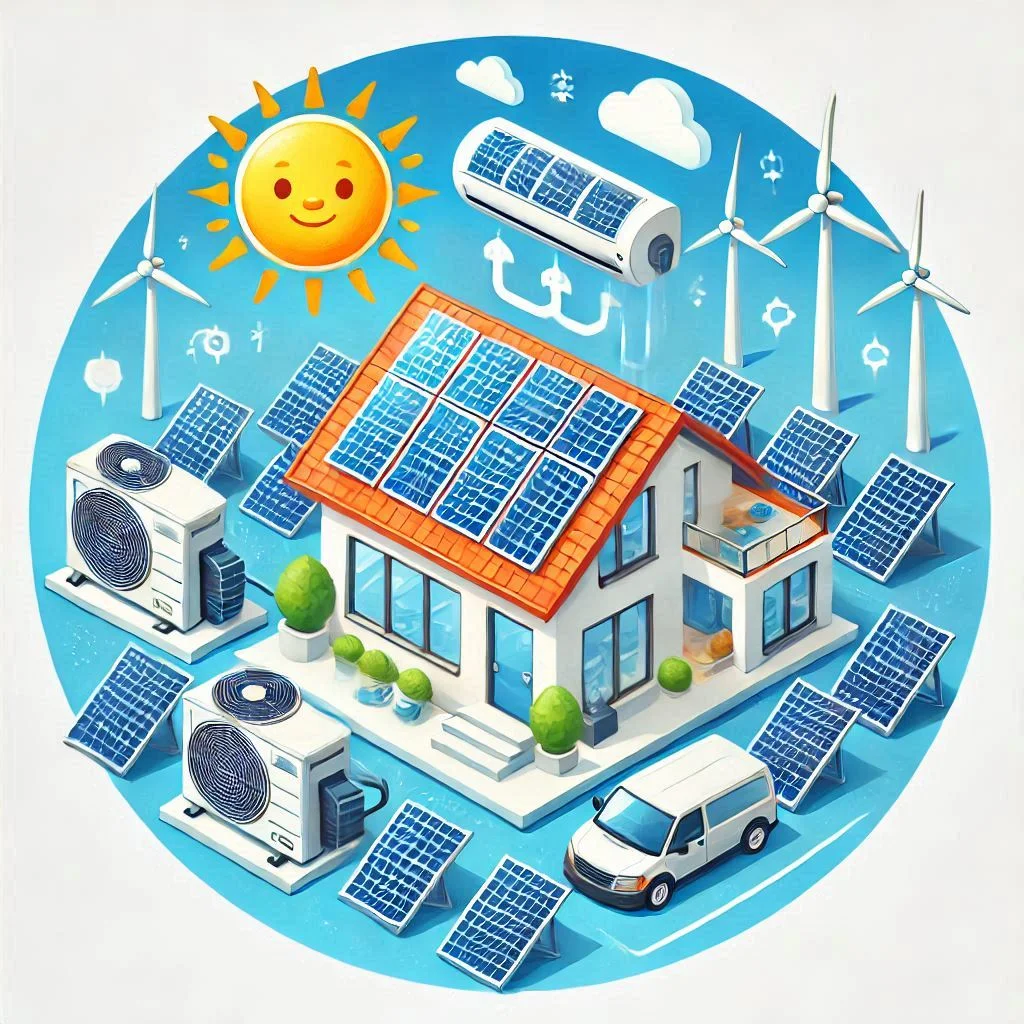
Nighttime Solar Power
At night, solar panels cannot generate power because they rely on sunlight. This creates a challenge for using solar panels to run an AC unit after the sun sets. However, there are solutions to ensure that your AC continues to run even when the sun isn’t shining.
- Energy Storage with Batteries: One effective solution is to incorporate a battery storage system. The excess energy generated during the day can be stored in batteries and used to power your AC during the night. This ensures continuous operation, even after the sun goes down.
- Grid-Tied Systems: In an on-grid system, solar panels feed excess power into the local grid. At night, when your solar panels aren’t generating electricity, you can draw power from the grid to run your air conditioner.
- Efficiency Considerations: If you are relying solely on solar power, it’s important to have enough battery storage to power the AC overnight or during cloudy days.
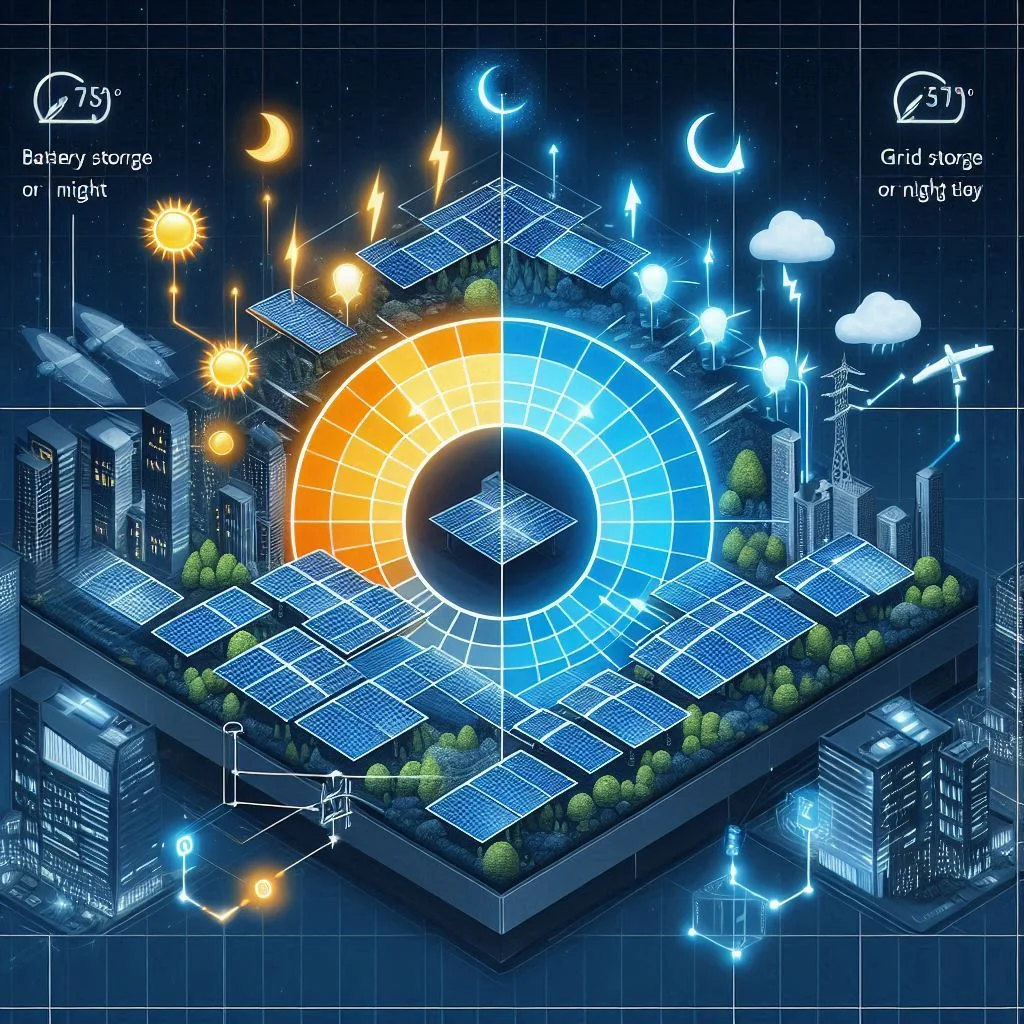
Solar Efficiency in Winter Conditions
Many people assume that solar panels are only effective in sunny, warm climates. However, solar panels can still be highly effective in winter conditions, though their performance can be influenced by the weather.
Impact of Cold Weather on Solar Panels
Solar panels perform better in cold weather compared to extremely hot conditions. This is because excessive heat can reduce the efficiency of the panels. In winter, solar panels are less likely to overheat, which means they can operate at a higher efficiency during daylight hours.
- Optimal Temperature: Solar panels have an optimal operating temperature range, typically between 15°C to 25°C (59°F to 77°F). In colder climates, solar panels can still generate electricity efficiently because the lower temperatures help keep the panels cooler.
Snow and Ice
While snowfall and ice can affect solar panel performance, they don’t completely render them ineffective. Solar panels can still generate power in snowy conditions if the snow isn’t covering the panels entirely. In fact, a layer of snow can sometimes help reflect sunlight onto the panels, increasing their efficiency.
- Maintenance: In areas where snow and ice accumulate, it is important to periodically clear off the snow to ensure that your solar panels continue to receive sunlight. Snow can block sunlight and decrease the amount of energy your panels generate.
- Winter Sunlight Hours: The amount of sunlight during winter months may be less than in summer, but solar panels can still perform well, especially in regions that experience long, sunny winter days.
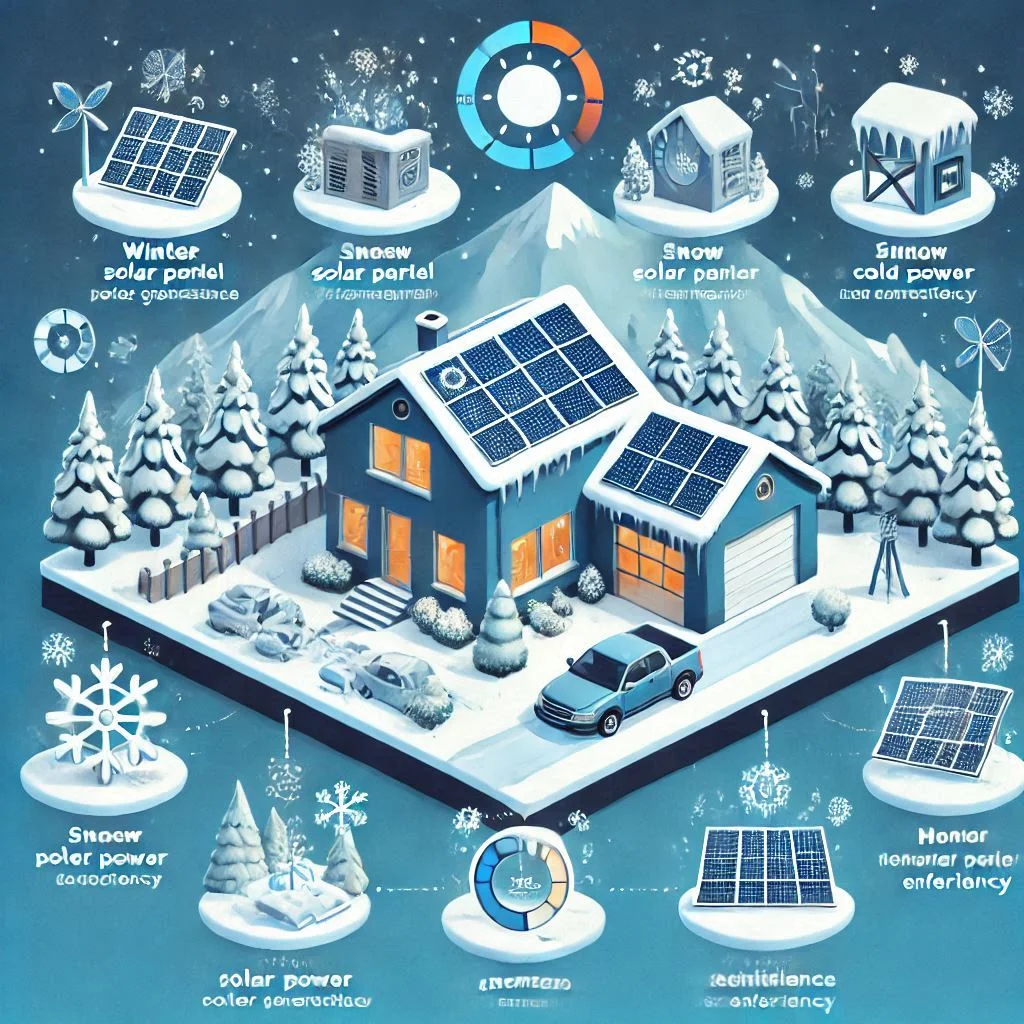
Solar Panels in Cloudy Weather
In regions that experience cloudy weather during the winter months, solar panel efficiency may decrease. However, diffused sunlight can still generate power. Although the efficiency is reduced, solar panels can still contribute to the energy needed to run an AC, especially when paired with battery storage.
- Battery Backup: For areas with frequent cloudy conditions, solar battery storage becomes even more essential to ensure that your air conditioner operates efficiently when solar power is insufficient.
- Energy Storage Capacity: To handle lower solar power generation during cloudy winter months, it’s recommended to have larger battery banks to store enough power for continuous AC use.
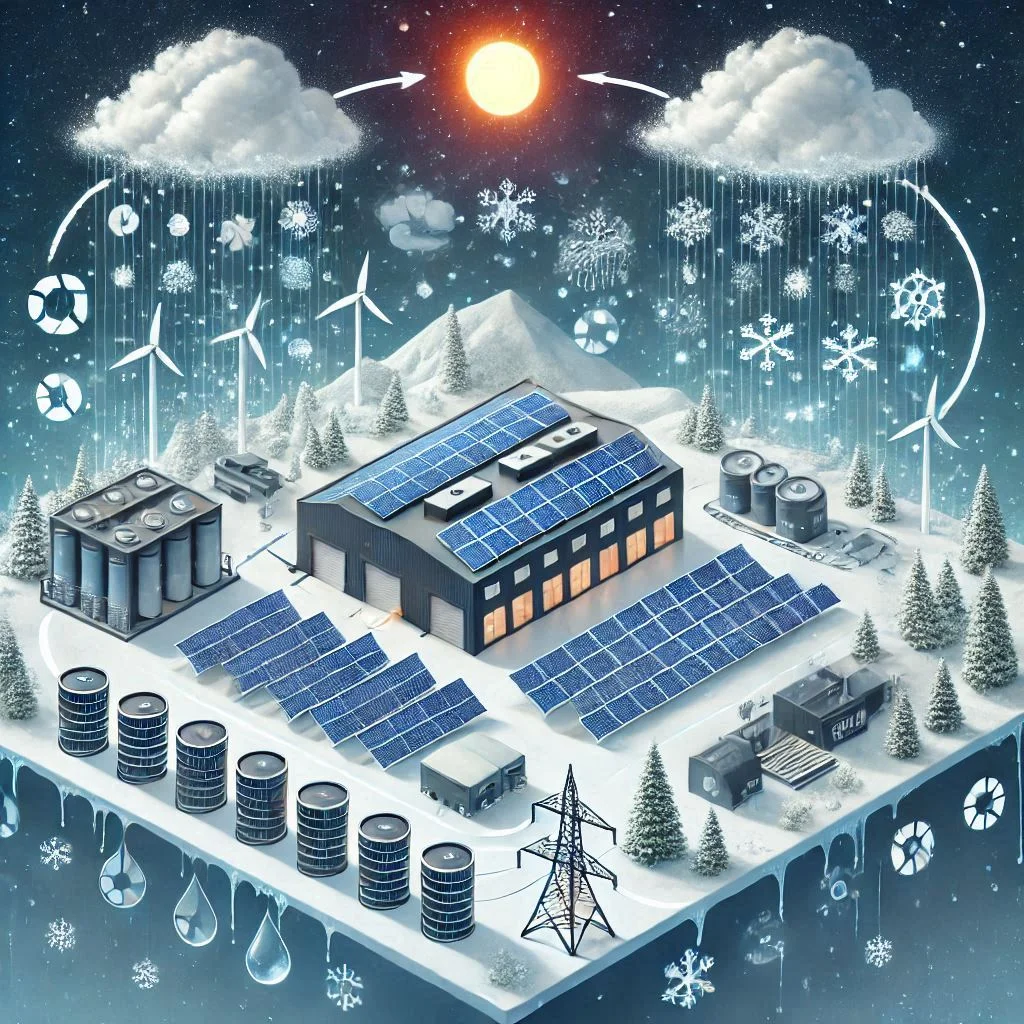
Comparing Solar AC Systems: On-Grid vs. Standalone
As more homeowners and businesses adopt solar energy to power their air conditioning systems, it’s important to understand the key differences between on-grid and standalone (off-grid) solar AC systems. Both types of systems have their advantages and are suitable for different needs. In this section, we’ll compare the two systems, helping you determine which is best for your needs.
What is an On-Grid Solar AC System?
An on-grid system, also known as a grid-tied solar system, is a solar energy setup that connects directly to your local utility grid. In this system, solar panels capture sunlight and generate electricity, which is used to power your air conditioning unit and other appliances.
- Solar Energy Usage: During the day, the solar panels generate electricity that is used to power your AC system. If your solar panels generate more energy than you need, the excess energy is sent back to the grid, and you may receive credits from your utility company (net metering).
- Grid Support: At night or during periods of low sunlight, when the solar panels are not generating enough power, your AC will draw electricity from the grid. This ensures continuous operation of your AC even when solar power is not available.
- Cost Efficiency: One of the major benefits of an on-grid system is that you do not need to invest in expensive battery storage since you can rely on the grid to provide power when your solar panels are not generating enough electricity. This makes on-grid systems less costly to install initially.
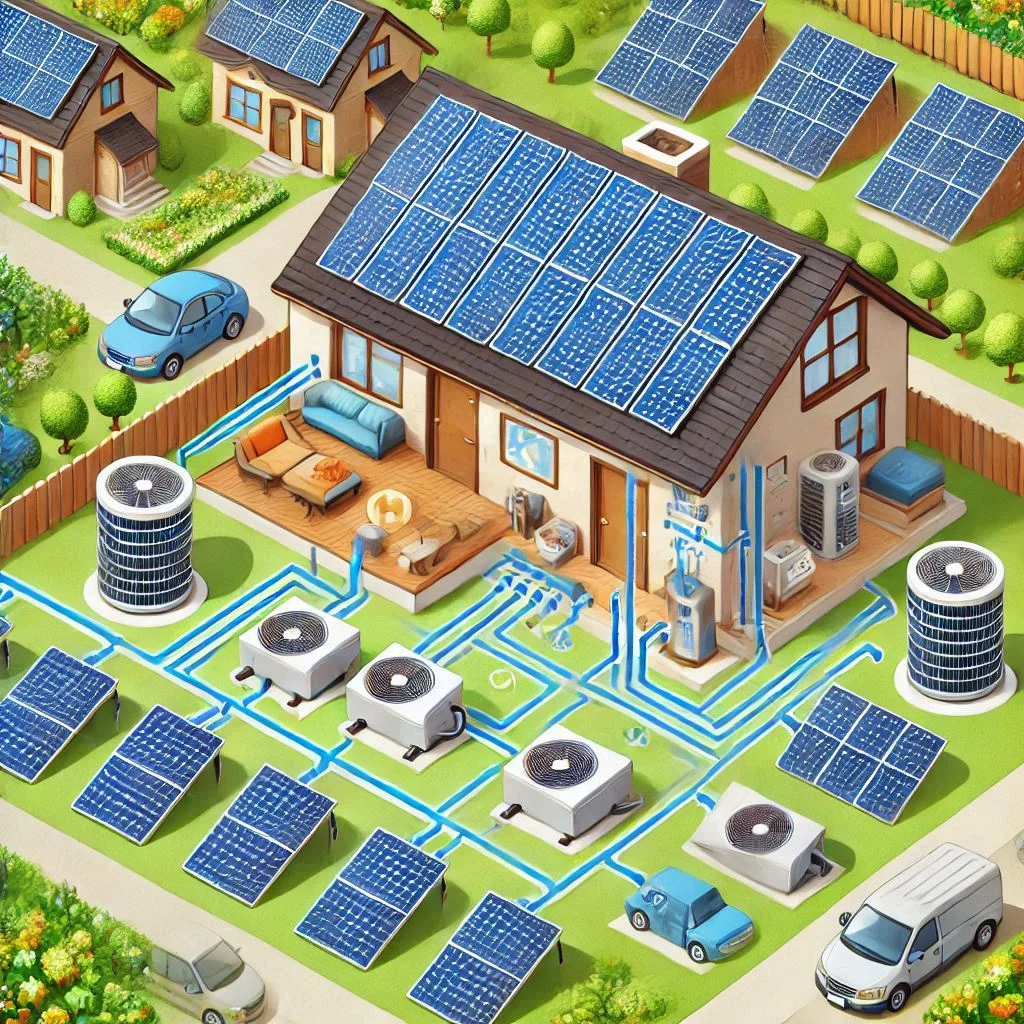
What is a Standalone (Off-Grid) Solar AC System?
A standalone or off-grid solar AC system is not connected to the utility grid. Instead, it relies solely on solar energy and battery storage to power the AC unit.
- Independent Power Supply: In an off-grid system, your solar panels generate electricity, which is then stored in batteries for later use. The stored energy powers your AC when needed, including at night or on cloudy days.
- No Utility Dependency: Since this system is entirely independent of the grid, you will not receive any electricity from the utility company. This makes off-grid systems perfect for remote areas or for people who want to be fully self-sufficient.
- Higher Initial Cost: One of the downsides of standalone solar systems is the higher initial investment, as you need to buy batteries for energy storage. Additionally, you’ll need to size the system appropriately to meet your AC’s energy demands, which may require more solar panels and a larger battery bank.
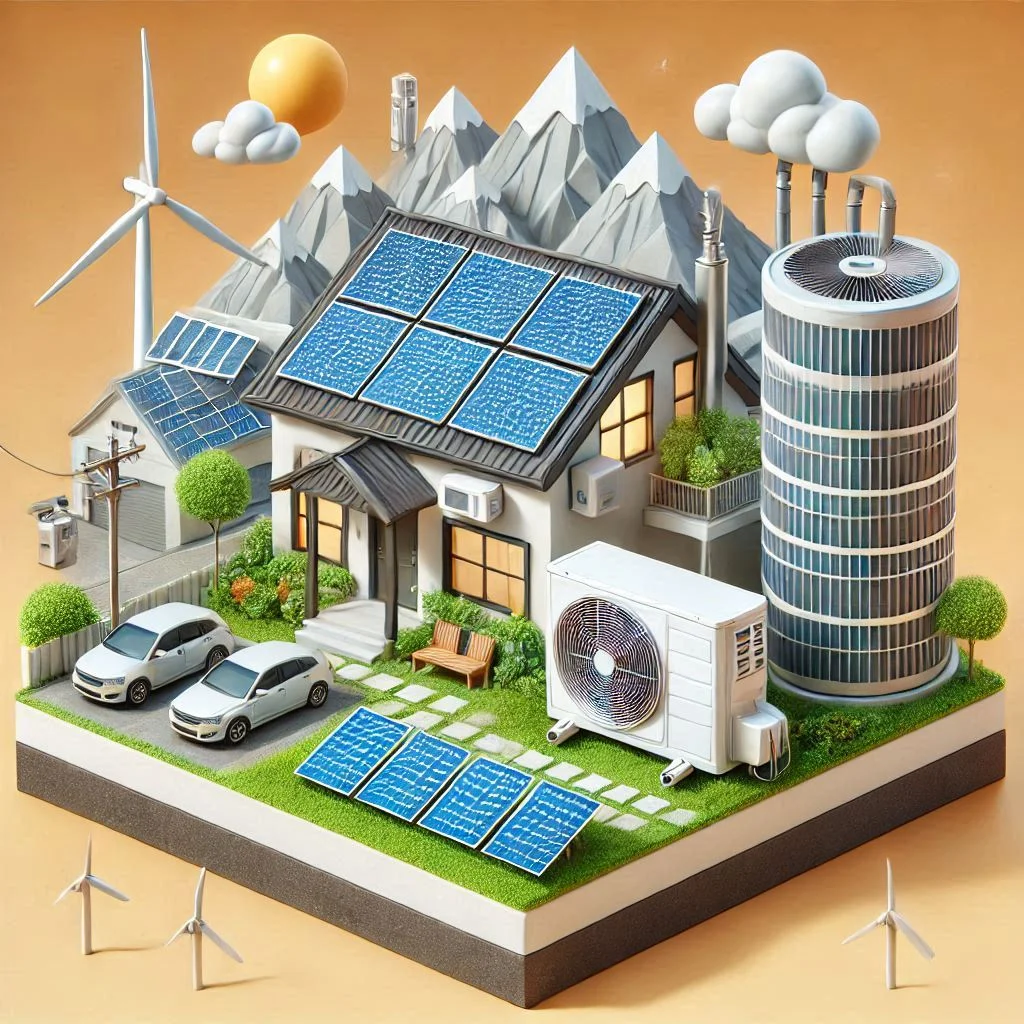
Building an Off-Grid System for AC
Building an off-grid solar system for air conditioning requires careful planning and system design. Since you’re relying solely on solar power and batteries, you need to ensure that your solar panels generate enough energy to meet your AC’s needs, even during periods when sunlight is limited.
Key Steps in Building an Off-Grid System
- Calculate Your AC’s Power Requirements: Before you start designing your off-grid system, you need to calculate the power consumption of your air conditioner. This is typically measured in watts or kilowatts (kW). Make sure to account for your AC’s running hours to determine the total energy needed.
- Determine Solar Panel Capacity: Once you know your AC’s power requirements, you’ll need to determine how many solar panels are required to meet those needs. Consider factors such as solar panel wattage, sunlight hours in your location, and seasonal variations in sunlight.
- Select the Right Battery Storage: To store the energy for nighttime or cloudy days, you need to choose the right size of battery storage. Calculate how much storage is necessary to keep your AC running during periods without direct sunlight. Consider deep-cycle batteries, which are designed for solar power systems.
- Inverter Selection: An inverter is required to convert the DC electricity generated by the solar panels and stored in the batteries into AC electricity that your air conditioner can use. Make sure to choose an inverter with sufficient capacity to handle your system’s load.
- System Maintenance: Regular maintenance is crucial for ensuring the longevity and efficiency of your off-grid system. Keep your solar panels clean, monitor your battery health, and ensure that all connections are secure.
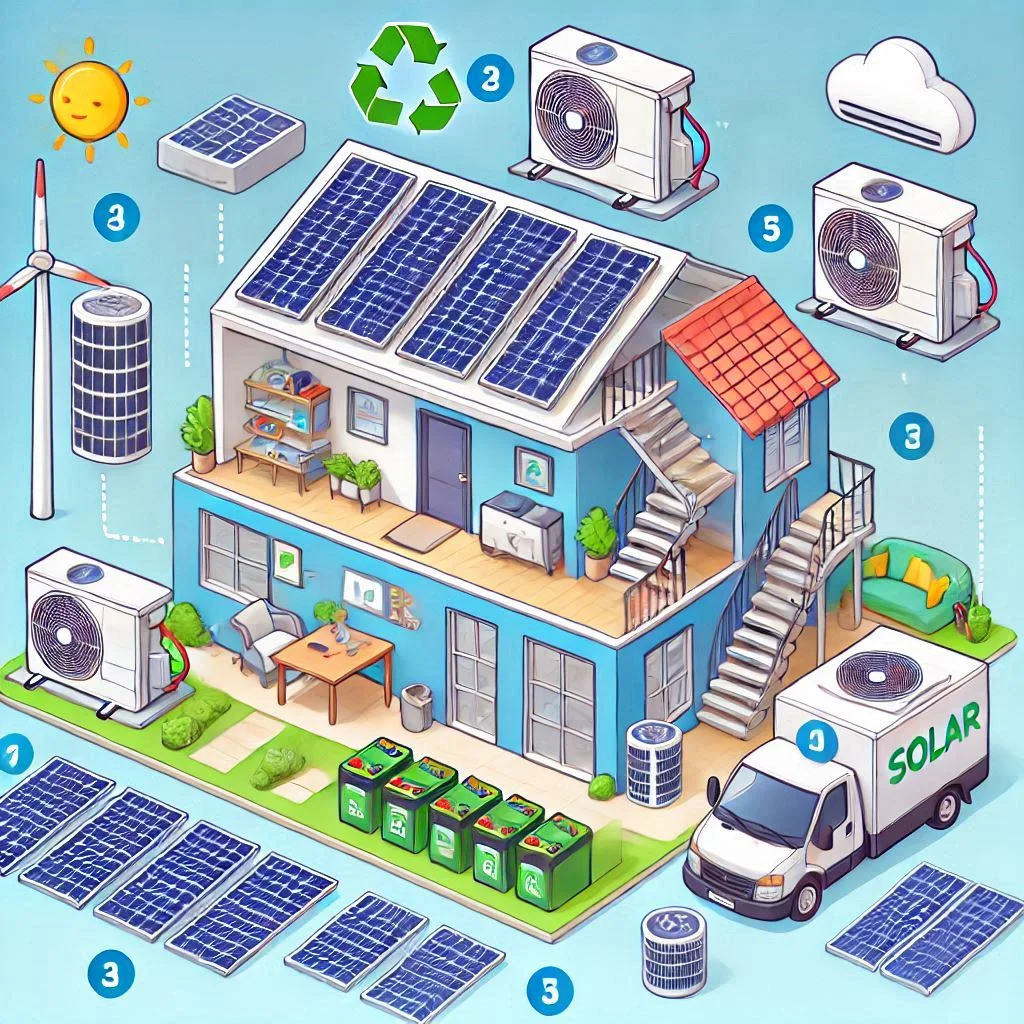
Integrating Battery Backup for Solar Air Conditioning
For both on-grid and off-grid solar AC systems, incorporating battery backup is a valuable option for ensuring your air conditioner runs efficiently, especially during times of low sunlight.
Why Battery Backup is Important
- Reliability: Batteries act as a buffer between the solar panels and your AC unit, ensuring continuous operation of your AC even when solar power is not being generated. For on-grid systems, batteries can provide energy during power outages, allowing you to continue using your AC.
- Energy Storage: Battery backup allows you to store the excess energy generated during the day for use at night or on cloudy days. This is particularly important for off-grid systems, where the grid is not available to draw power from.
- Optimizing Solar Usage: Battery storage systems allow you to maximize your solar power usage, reducing your reliance on grid electricity and saving on energy costs.
Key Considerations for Battery Backup
- Battery Capacity: Ensure that the battery capacity is sufficient to meet the energy needs of your AC system. The larger the battery capacity, the longer your AC can run during off-sunlight hours.
- Battery Type: Choose a battery type that suits your system. Lithium-ion batteries are popular due to their long lifespan and efficiency, but lead-acid batteries can be a more affordable option, though they have a shorter lifespan.
- System Compatibility: Make sure that your solar panel system, battery storage, and inverter are compatible with each other to ensure smooth and efficient operation.
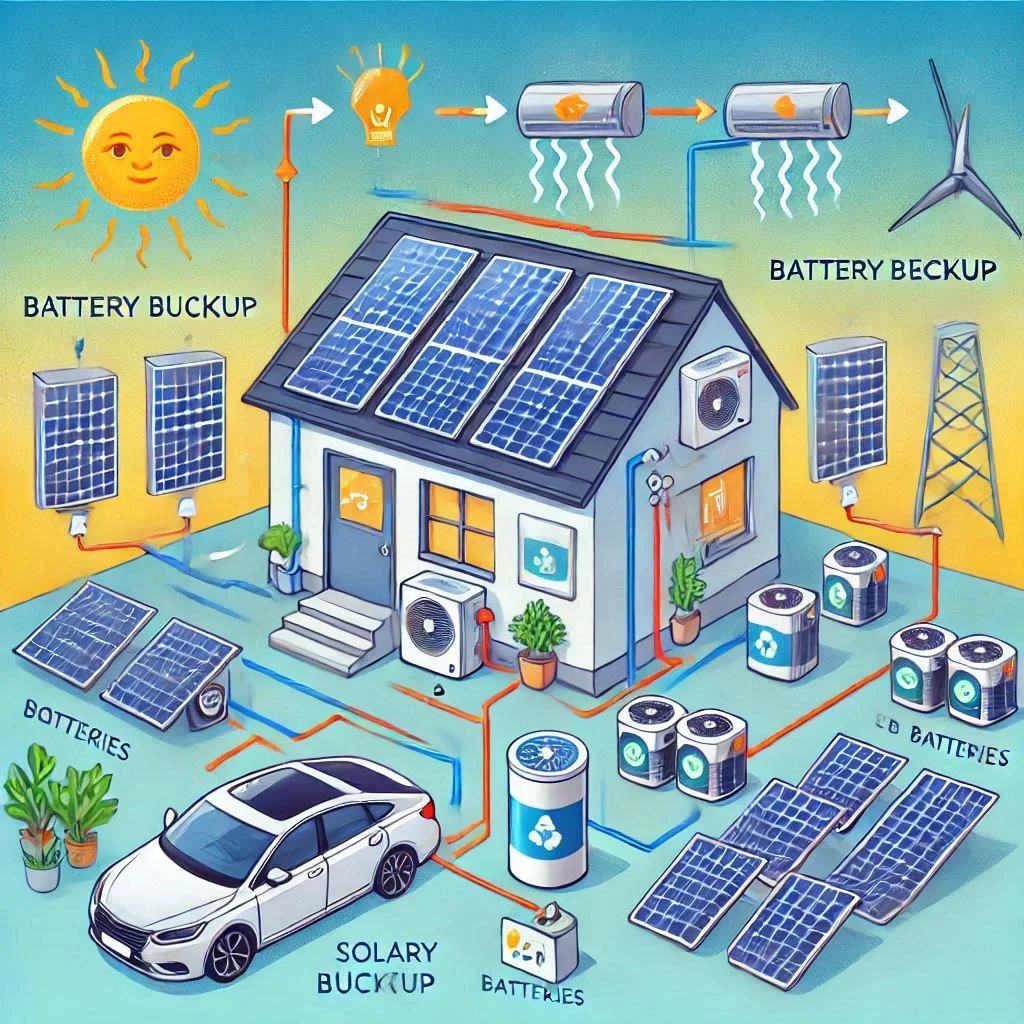
FAQs About Solar Panels for Air Conditioning
1. How Many Solar Panels Do You Need to Run an Air Conditioner?
The number of solar panels required to run an air conditioner depends on various factors, including the size of the AC unit, its energy consumption, and the solar panel output. A standard 1.5-ton air conditioner typically consumes about 1,500 watts per hour during peak operation. To run this AC on solar power, you’ll need to calculate the total energy consumption and then determine how much solar energy is required to meet that demand.
Key Factors:
- AC Power Consumption: Calculate the power usage of your AC in watts.
- Solar Panel Wattage: Standard solar panels typically generate between 250-350 watts of power.
- Sunlight Hours: The number of sunlight hours in your location will affect how much energy your solar panels generate each day.
For example, if you need 1,500 watts per hour, and each panel produces 300 watts, you would need about 5 panels to meet the energy demand during sunny hours.
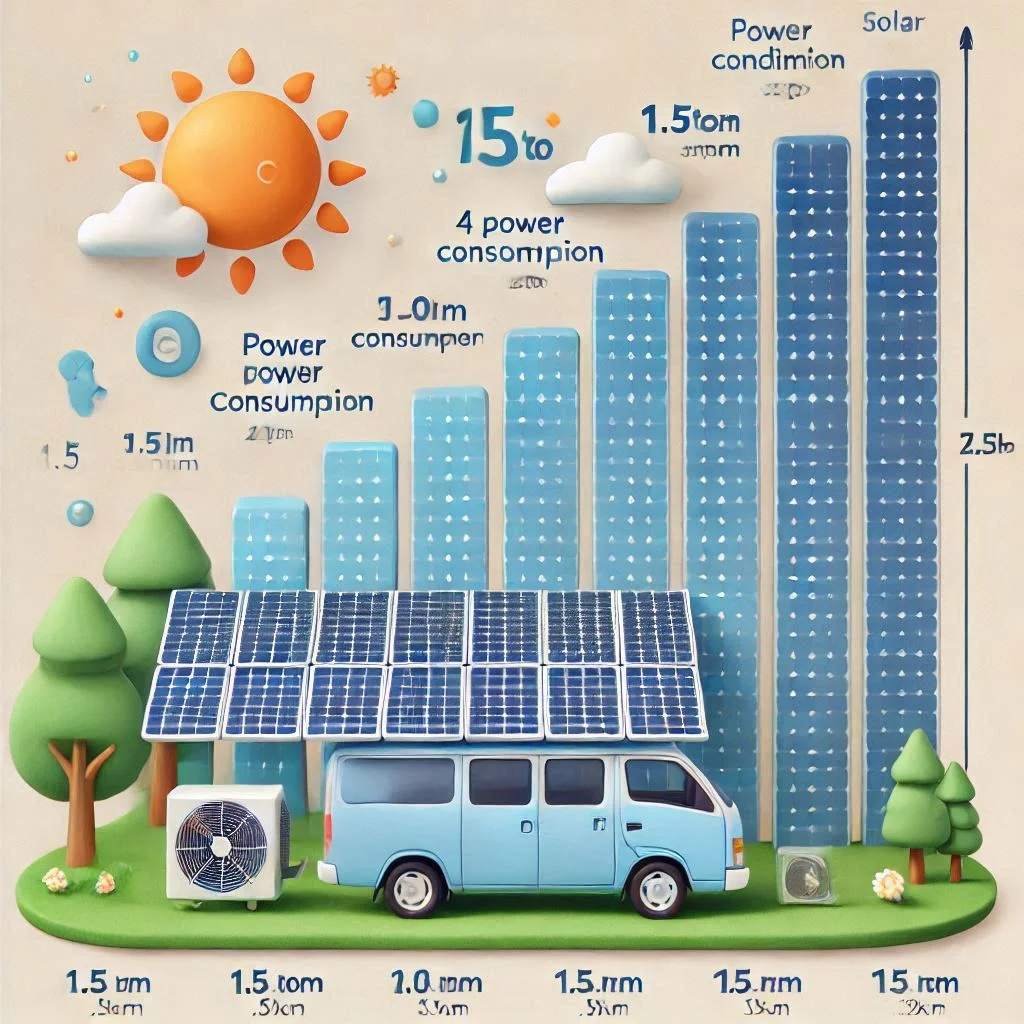
2. Can You Run an Air Conditioner on Solar Power?
Yes, you can run an air conditioner using solar power, but you need to ensure that your solar panel system is properly sized to handle the energy demand of your AC unit. The system must generate enough electricity during the day to power your AC, and you may need battery storage to maintain power during nighttime or cloudy days.
On-Grid vs. Off-Grid Systems:
- On-Grid Systems: These systems are connected to the local utility grid. If your solar panels generate more energy than needed, the excess is sent back to the grid, and you may earn credits. If your panels don’t produce enough, the grid will supply the necessary power.
- Off-Grid Systems: These systems are completely independent and rely on battery storage to power the AC unit when sunlight is unavailable. Off-grid systems are ideal for remote locations where grid access is limited or unavailable.
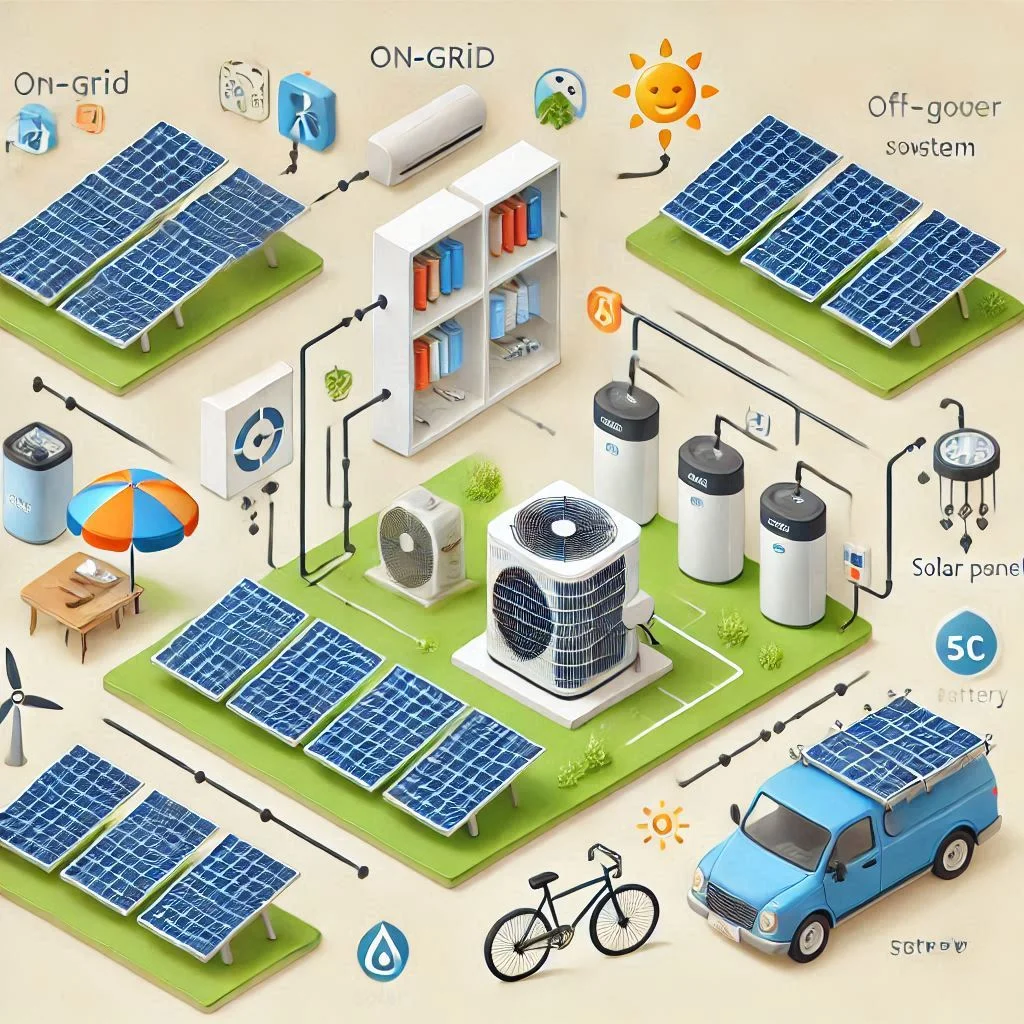
3. What Is the Ideal Solar Panel Capacity for an Air Conditioner?
The ideal solar panel capacity depends on the energy consumption of your air conditioner and your location’s solar potential. To calculate the necessary solar panel capacity, you should follow these steps:
- Calculate your AC’s energy consumption: Determine how many watts your AC unit uses per hour and the total hours it runs daily.
- Consider panel efficiency: Solar panels vary in their wattage, typically ranging from 250 watts to 350 watts per panel. More efficient panels may reduce the total number of panels needed.
- Account for energy storage: If you plan to use battery storage (for off-grid systems), you’ll need to ensure that the system can store enough energy to meet your needs overnight.
Typically, for a 1.5-ton AC, you’ll need around 5-6 solar panels with a capacity of 300 watts each to operate during peak sunlight hours.
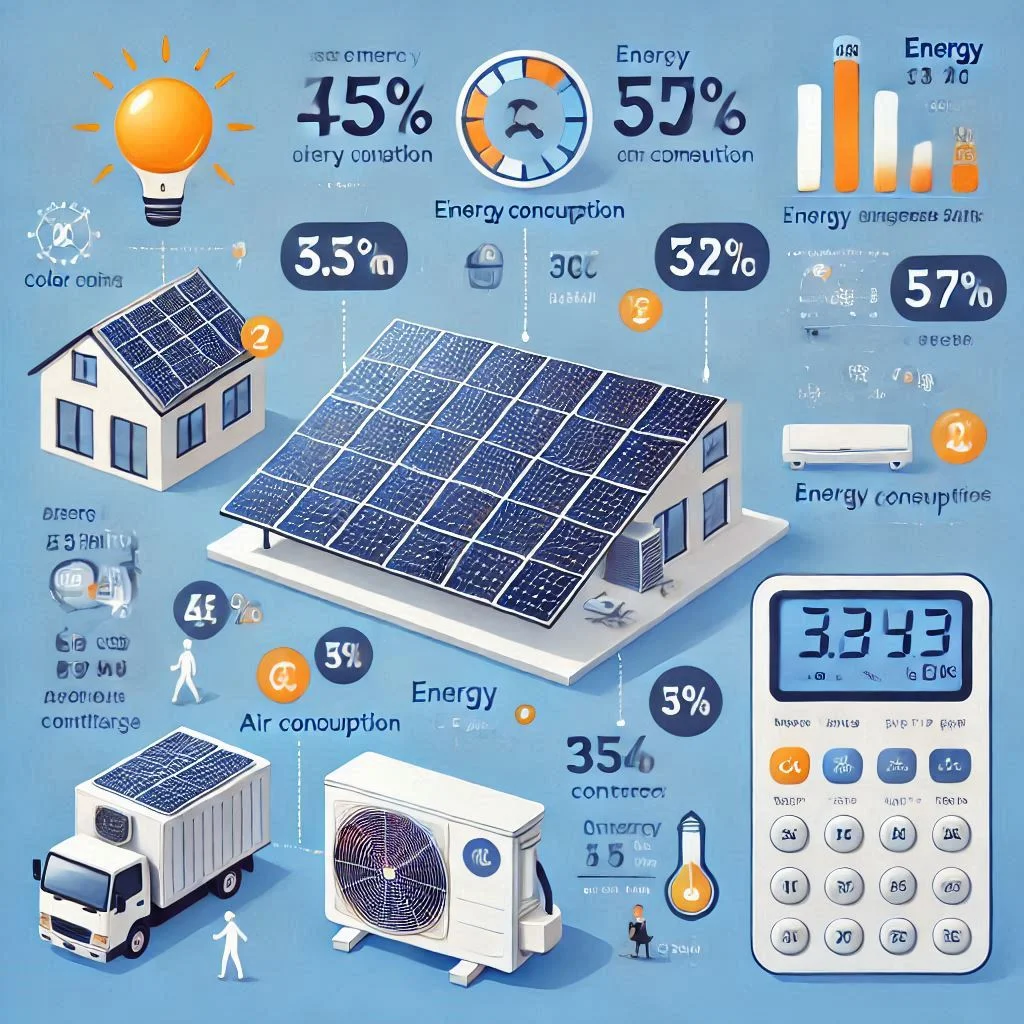
4. How Efficient Are Solar Panels for Air Conditioning?
Solar panels can be very efficient for powering air conditioning units, especially in areas with abundant sunlight. The efficiency of solar panels depends on:
- Solar Panel Efficiency: Modern panels have an average efficiency of 15-20%. The higher the efficiency, the fewer panels you’ll need to generate the required energy.
- Environmental Factors: The amount of sunlight your location receives daily is a key factor in determining solar power efficiency. Locations with fewer cloudy days and more sunlight will allow solar panels to operate at their best.
For air conditioning, ensuring that you have a solar panel system with adequate battery storage (for off-grid setups) or grid support (for on-grid setups) is crucial to maintain consistent power, especially during periods of low sunlight.
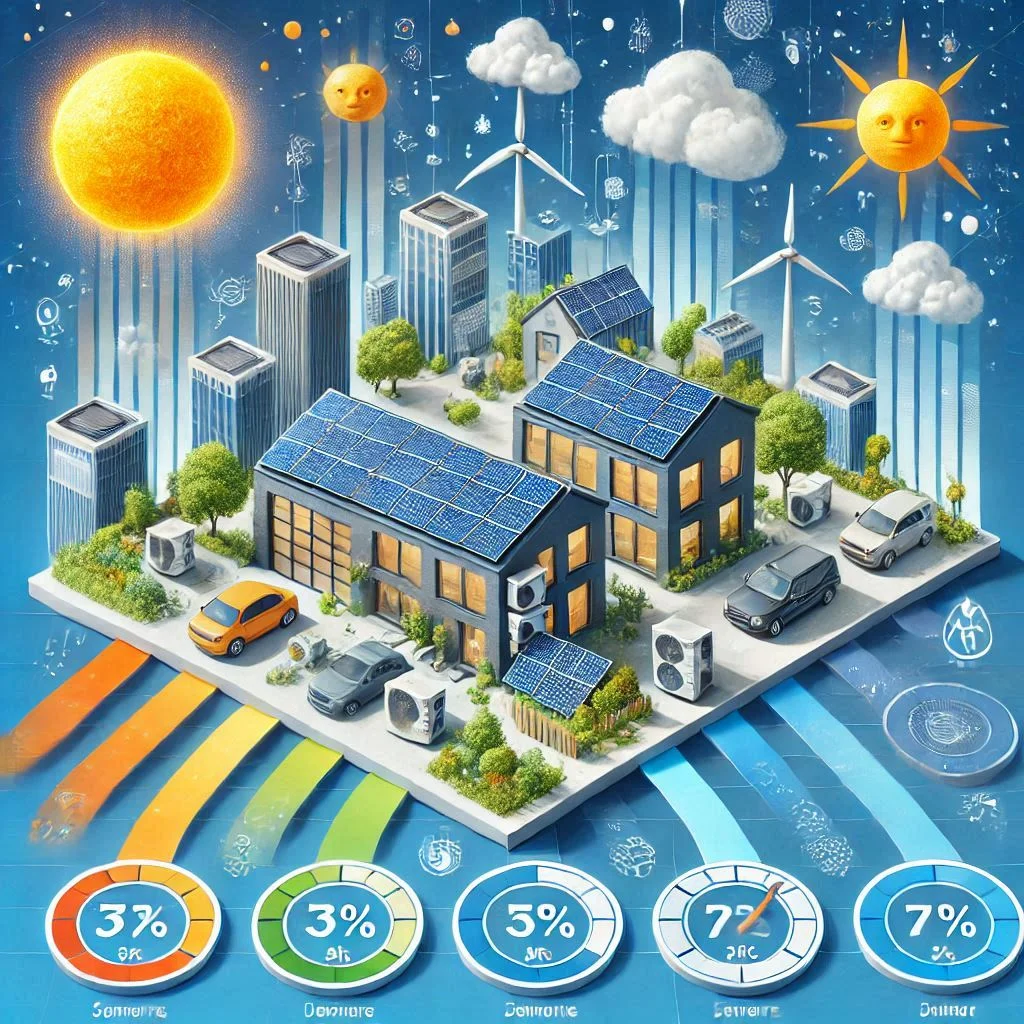
5. How Much Do Solar Panels Save on Air Conditioning Costs?
Switching to a solar-powered air conditioning system can lead to substantial savings in electricity bills, especially if your AC runs frequently during the summer months. Solar panels help offset the cost of electricity, reducing the need to rely on the grid for power.
- Cost Savings: After the initial installation of the solar system, you can save on your monthly energy bills by using the free energy generated by the sun.
- Return on Investment: Over time, the cost of installing solar panels is recouped through the savings on energy costs. The average payback period for a residential solar panel system is typically between 5 to 10 years.
However, the total savings depend on factors such as the size of the system, the cost of electricity in your area, and your air conditioning usage.
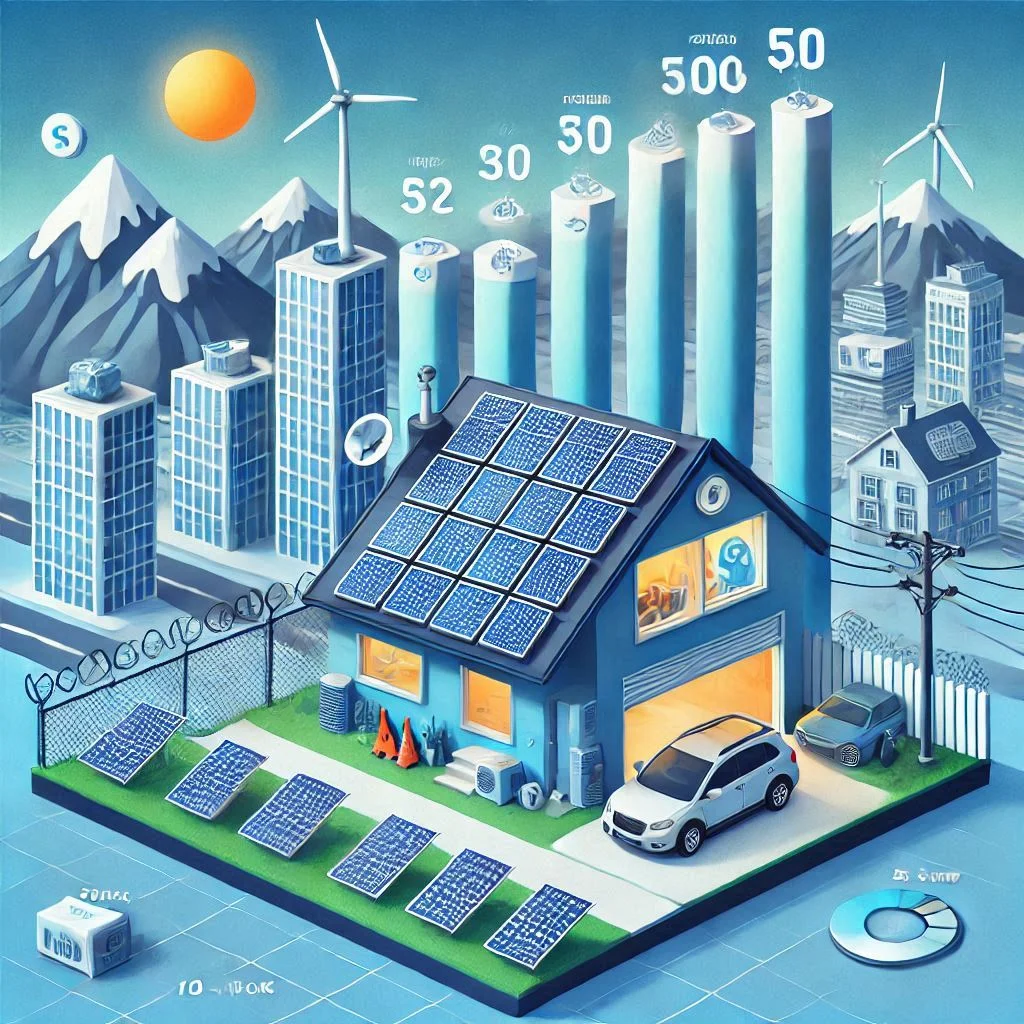
6. Can Solar Panels Work in Winter for Air Conditioning?
Yes, solar panels can still work in winter, but their efficiency may be reduced due to fewer sunlight hours and cloud cover. However, solar energy production is not limited to warm weather; the panels can still generate power on cold, sunny days.
Key Points to Consider:
- Snow Impact: Snow can cover the panels, reducing their efficiency temporarily. However, once the snow melts or is cleared, solar panels will resume normal function.
- Longer Nights: In winter, the longer nights mean that your battery storage will need to be sized larger to ensure you have enough power for your AC during off-sunlight hours.
If you’re relying on solar power year-round, you may need to consider a larger solar panel system or additional battery storage to handle the reduced output in winter.

Conclusion:
In conclusion, powering your air conditioning system with solar panels is an excellent way to reduce energy costs, increase energy efficiency, and make a positive impact on the environment. By understanding the factors that influence solar panel requirements, such as the type of AC unit, the number of solar panels needed, and the efficiency of the system, you can make informed decisions about the best solar solution for your home or business. Whether you opt for an on-grid or off-grid system, or incorporate battery storage, solar energy offers flexibility and sustainability. By following the guidelines in this blog, you can confidently choose the right solar system to keep your space cool while enjoying the long-term benefits of renewable energy.

